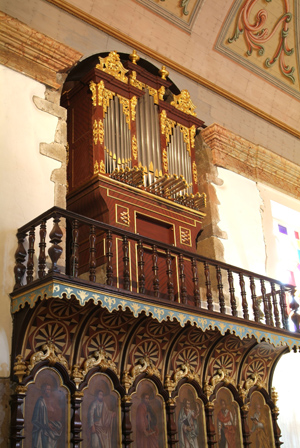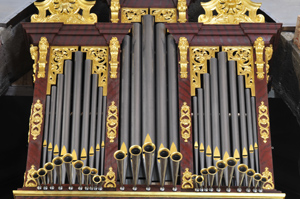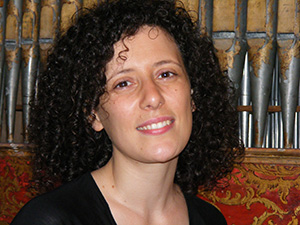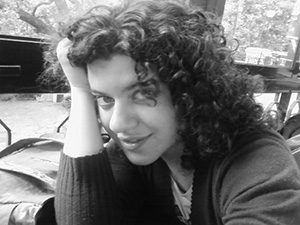 Sunday, 27 October 27, 6.00 p.m.
Sunday, 27 October 27, 6.00 p.m.
Church of Nossa Senhora da Conceição
Edite Rocha: organ
Mariana Pimenta: soprano
Made up of 18th century music written in Portugal, this concert offers a varied panorama of Portuguese and Italian composers working for the Portuguese court. Divided stylistically into two parts, the programme is unified by the predominance and affirmation of the Italianization of musical language in Portugal. Thus, we hear composers who predominated in the first half of the 18th century, such as Carlos Seixas, Rodrigues Esteves and Giovanni Giorgi, and composers more representative of the second half of the century and the beginning of the next, such as Silva Leite and Marcos de Portugal.
Employed by the Royal Court, José António Carlos Seixas, born in Coimbra and considered a great performer and the most representative composer of keyboard music of the first half of the 18th century, opens this exploration with one of the 118 sonatas presently identified. The Neapolitan David Perez (1711-1778) was already an established composer, especially of opera, when he was contracted in 1752, serving as composer and chapelmaster to the royal family. The two works performed today come from the Missa de Santa Joana, for an ensemble of five voices and basso continuo, written probably for the religious services at the Convent of Santa Joana in Lisbon, or the commemorations of the elevation of Aveiro to a bishopric in 1774.
Manuel de Santa Elias, known particularly for his religious music, was a monk of the Order of St Paul in Lisbon, and, from 1767, the Brotherhood of St Cecilia, where he was both master of music and organist. Also from the Convent of St Paul, Frei Jacinto do Sacramento, of whom little is yet known, was known as one of the best organists and keyboard players in Lisbon.
João Rodrigues Esteves (1700-1751) was one of those awarded a grant by King John V to study in Rome, later being appointed Master of the Royal Patriarchal Seminary, an institution distinguished for its high quality. Also from Rome, Giovanni Giorgi (end of 18th century – 1762) was contracted by the Portuguese Court in 1725, continuing there his career as a composer principally of sacred music.
Ant da Silva Leite (1759-1833) worked in various musical genres, including opera, chamber music and the modinha, but it is his sacred music (written principally for the Monastery of St Benedict in Oporto) that is best known today.
The final section of the concert is dedicated to the most successful Portuguese composer of the time, Marcos António da Fonseca Portugal (1762-1830), known for more than seventy dramatic works, including some forty operas and more than 140 religious works, whose variety may be seen in the music chosen to close this concert.
Edite Rocha
Carlos Seixas (1704-1742)
Sonata in G minor * (organ solo)
Allegro
Adagio
Allegro
David Perez (1711-1778)
"Domine Deus" (from Missa Santa Joana)
Anónimo (séc. XVIII)
Discurso de 1º Tom (organ solo)
David Perez
"Quoniam" (from Missa Santa Joana)
Fr. Manuel de Santo de Elias (séc. XVIII)
Sonata in D minor (organ solo)
Allegro
João Rodrigues Esteves (1700-1751)
"Fac me vere" (from Stabat Mater)
Fr. Manuel de Santo de Elias
Sonata in D minor (organ solo)
Adagio
Giovanni Giorgi (fim do séc. XVII-1762)
"Esurientes" (from Magnificat)
Fr. Manuel de Santo de Elias
Sonata in D minor (organ solo)
Allegro
António da Silva Leite (1759-1833)
"Paratur Nobis Mensa Domini"
Marcos Portugal (1762-1830)
"Et incarnatus est" (from Missa Grande)
Fr. Jacinto do Sacramento (séc. XVIII)
Sonata in D minor (organ solo)
Marcos Portugal
"Laudamus te"( from Missa Grande)
Andante with variations (organ solo)
"Teneri e cari affetti" ( from the opera La Morte di Mithridate)
Participantes
|
Edite Rocha graduated in Musical Education (1999) at the University of Aveiro, under the supervision of João Pedro de Oliveira and Domingos Peixoto, studied organ at the Conservatoire National de Région de Musique, Danse et Art Dramatique de Perpignan (France) with Jean-Christoph Revel, took a masters in early music (2004) from the Schola Cantorum Basiliensis (Basle, Switzerland) under the supervision of Jean-Claude Zehnder and Andrea Marcon – with the support of the Office of International Relations of the Ministry of Culture – and a doctorate in music at the University of Aveiro (2010) – with the support of the Foundation for Science and Technology. She has given a number of organ concerts (as a soloist and with ensembles and orchestra) in various European countries and Brazil, organ master classes, and has also given a number of lectures and published on the theory and practice of historically informed performance on keyboard instruments of the 16th – 18th centuries, particularly with regard to the life and work of Manuel Rodrigues Coelho, winning the “D. Manuel I” Prize for Historical Research in Elvas in 2011. She is currently a researcher at the Institute of Ethnomusicology – Centre for Studies in Music and Dance (INET-md), conducting post-doctoral research (FCT) at the Universities of Aveiro and Oxford, is the president of the committee of the Musical Association Pro-Organo (AMPO) and teaches organ at the University of Aveiro. |
|
Born in Madeira, she began her musical studied at the GCEA (Gabinete Coordenador de Educação Artística) at the age of seven, taking choir and piano classes. She studied singing at the Conservatory – Professional School of Arts in Madeira. As part of the Leonardo Da Vinci project, she worked with the baritone Leonard Mroz, at the Warsaw Conservatoire. She attended singing master classes with António Salgado, Pat McMahon, Laura Sarti, Susan Waters, Fernanda Correia and the vocal group Cappella Pratensis. She was a soloist in the musical Madeira, by Jorge Salgueiro. She is a member of the junior choir, the Regina Pacis vocal group, at the GCEA, and of the Madeira Chamber Choir, under the direction of Zélia Gomes. She was a member of the choir in the operas Amor de Perdição by João Arroyo, the Threepenny Opera by Kurt Weill and Don Giovanni by Mozart, conducted by António Saiote, part of the opera studio OperaNorte. She worked with the Ensemble Joanna Musica, directed by Mário Trilha, in a national tour, with music by David Perez. She was a soloist in the Te Deum by Lully and Charpentier, in the Vespers by Monteverdi, and the Requiem by Victoria. She is a member of the group Vocal Ensemble, conducted by Vasco Negreiros, with whom she sang in programmes for the Music Days at the CCB. She was a soloist on the Camerata Antiqua project, under the direction of Vasco Negreiros. She graduated in singing at the University of Aveiro, stdying with António Salgado and Joaquina Ly. She is currently completing a master’s degree in music for vocational teaching at the University of Aveiro. |
Notes about the Organ
 Church Nossa Senhora da Conceição, Machico
Church Nossa Senhora da Conceição, Machico
In the historical documentation from before the 20th century there are references to two instruments: according to historical tradition, one was given to the Church of Nossa Senhora da Conceição in 1499 by King Manuel, and another acquired in 1746. As regards the Manueline organ, we may deduce that it was placed within the archway above the choirstalls on the Gospel side of the sanctuary. In the 18th century, the state of this instrument must have left much to be desired, leading to the acquisition of the second instrument in 1746. The organ arrived in Madeira in 1752, with the Council of the Treasury initially contributing the cost of purchase and later the installation costs.
The recent restoration undertaken by Dinarte Machado was done with the principal objective of returning as far as possible it to its original constitution, in accordance with indications to be gleened from the pieces of the instrument during its dismantling. Thus, the restoration always proceeded from a philosophy of taking into account the specificities of the original pieces, from the configuration of the case and its polychrome decoration, to the way the registration, pipiework, bellows-work and even its placement – in the sanctuary – were returned to how they were originally. As regards the composition of the stops, the split keyboard, with the reed stop in the right hand, which the organ indicated was an original feature, which indeed characterised the instrument. The original keyboard, which was found piled in a heap, and which it was possible to repair and reassemble retains the short octave, as was usual at this period. The new pipework was completed with great rigour in accordance with the characteristics of the few original pipes that had survived, compared with the actual indications and dimensions of the windchest, which was also studied and recorded in great detail.
There can be no doubt that this is one of the loveliest organs on the island of Madeira. It is one of the instruments that conserves some of the most typical features of Portuguese organ building in the 17th century. It should be stressed that the restoration work carried out on this instrument required study of considerable documentation, as well as comparison with other instruments of the period. Since no other instruments of this kind are to be found in Portugal, recourse was had to instruments from other countries for the necessary data.
Manual (C, D, E, F, G, A-c’’’)
Flautado de 12 palmos (8’)
Flautado de 6 palmos (4’)
Flauta doce
Dozena (2 2/3’)
Voz humana (c#’-c’’’)
Quinzena (2’)
Composta de 19ª e 22ª
Sesquialtera II (c#’-c’’’)
Clarim* (c#’-c’’’)
* horizontal reeds

